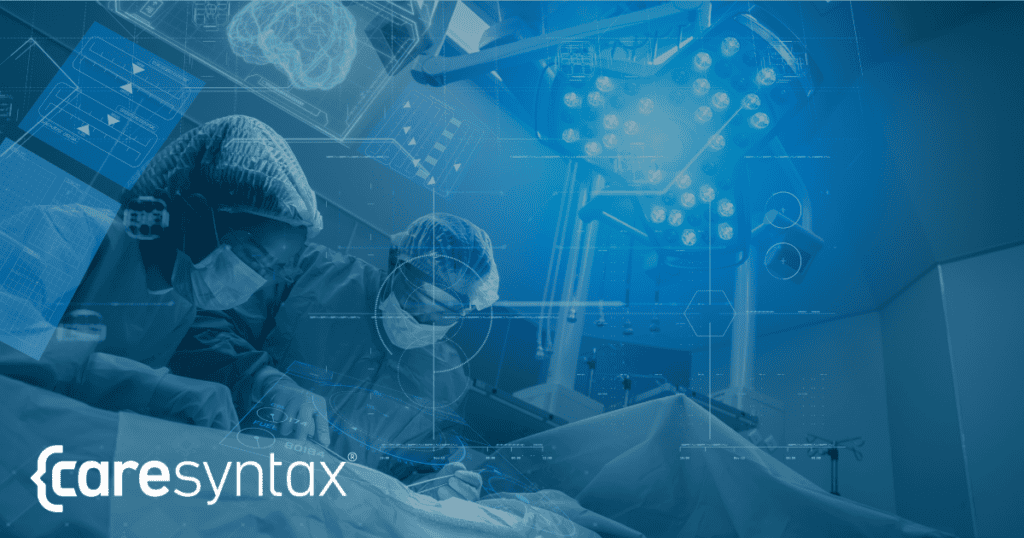
Blog
Are You Getting The Most Out Of Your Integrated Operating Room?
Learn More

Caresyntax Blog
February 17, 2025
The healthcare landscape is rapidly evolving, demanding innovative approaches to improve patient outcomes and streamline operations. At the heart of this transformation is the strategic capture of real-world data (RWD) to generate meaningful real-world evidence (RWE) for commercial and regulatory purposes. While clinical trials and registries have established the gold standard for the regulatory approval pathway, they fall short in capturing the nuances and complexities of real-world patient care. Medtech and industry innovators, through RWE partners like Caresyntax, are pioneering a new pathway to quantify the value of both existing and new products on the market, cost-efficiently and in an accelerated fashion, through measurement and focus on overall value of care.
At last year’s AdvaMed MedTech Conference, Caresyntax’s Bruce Ramshaw (Chief Medical Informatics Officer), and Taiki Esheim (SVP, MedTech and RWE) shared their insights into the transformative power of RWE and how Clinical Data as a Service (CDaaS) is altering the clinical evidence landscape for clinicians and medtech partners. Their discussion highlighted how innovative approaches with RWD address gaps in traditional methodologies, accelerate market readiness, and unlock new opportunities for precision care.
Randomized Controlled Trials (RCTs) are considered the gold standard for establishing safety and efficacy for new products, via peer-reviewed reproducibility and carefully tracked trial outcomes. However, due to their use of strict protocols and inclusion/exclusion criteria, these same rigid structures often fail to capture the complexities and variability of real-world healthcare delivery.
After a product receives approval, patient registries are often used to collect valuable aggregated data. However, they often lack the granularity needed to reflect the nuances of everyday patient care. And, real-world care is quickly stratifying into different sites of care from traditional hospital settings to ambulatory surgical centers (ASCs) and outpatient centers, resulting in shifts in team composition, patient management strategies, and workflows.
These gaps in data collection create challenges in measuring care delivery across diverse contexts, which is why medtech companies are shifting focus toward more inclusive, adaptable collection of real-world data.
“Real-world data is about listening—really listening—to what is happening in the care environment, not what we hope is happening based on controlled protocols.”
By leveraging RWD, companies can bridge gaps in traditional RCT and registry collection methods, capturing realistic variability and product use across diverse clinical environments.
Medtech innovators can leverage the power of RWE to reduce time to market, increase commercial opportunities, and to address the needs of specific subpopulations throughout the product lifecycle. One new product is the IDE Wrapper, a RWE module from Caresyntax, which can collect clinical and financial real-world data alongside a partner’s existing pre-
market trials. This approach equips medtechs with robust datasets for claims development and market positioning immediately upon regulatory approval.
“Imagine if you were able to go through your normal IDE process, but alongside that, collect outcomes data to understand what’s truly happening with those patients. You come to market not just ready to play, but ready to win.”
And, in addition to hitting the ground at running speed, RWE allows companies to extend the reach of their products into adjacent subpopulations, who are sometimes left behind due to the economics of cost vs market size. Pediatric patients are one example of a subpopulation that could benefit significantly. Regulatory and commercial hurdles often leave this group unaddressed, but RWD collection provides a cost-effective path to validate safe use in the real-world setting. Through its clinical quality improvement and data collection methods, Caresyntax has already successfully contributed to expanded labeling of products for use in pediatric patients.
The transition from volume-based to value-based care necessitates the use of Continuous Quality Improvement (CQI) frameworks. CQI relies on iterative care improvements based on real-time insights, driving better outcomes for patients and healthcare providers alike. In essence, CQI instills agile and lean principles into clinical practice.
“Agile management allows medtech to stay ahead of the curve by fostering continuous innovation cycles.”
CQI projects at the site of care can also translate to rapid innovation for medtech products and commercial strategies. These methodologies enable industry players to iterate rapidly, refining their innovation pipeline in response to real-world feedback instead of retrospective data
Despite the wealth of healthcare data available, much remains siloed and underutilized. Most healthcare decisions are focused on short-term costs and reduction of adverse events, without quantifying the overall value impact of each component within the system. Caresyntax addresses this challenge by integrating clinical, financial, and operational metrics into unified datasets. Datasets can include measures from pharmacy, biomed, supply chain, post-anesthesia care unit (PACU), surgical video, and any other recorded value in the continuum of care. These comprehensive datasets empower stakeholders to derive actionable insights, optimize care delivery, and improve financial performance.
“Imagine what the industry could achieve if we harnessed the full potential of this untapped data.”
Solutions like CDaaS offer medtech partners new insights, support, and evidence, transforming the entire lifecycle from product development to clinical implementation.
You can view the entire interview here
Discover how Clinical Data as a Service (CDaaS) by Caresyntax can transform your MedTech journey. From accelerating time-to-market, to optimizing product performance in diverse care environments, CDaaS empowers you with actionable insights to measure and improve the true value of care.